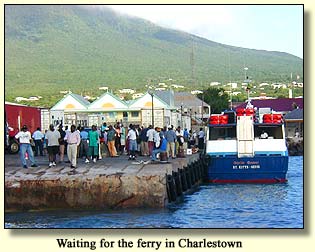| Home
Page
History & Culture
Admiral
Horatio Nelson
Points
of Interest
Brimstone
Hill Fortress
Basseterre
Nevis
Charlestown
Beaches
Activities
Diving
Fishing & Boating
Golfing
Eco-Adventures
Travel
Tips
Transportation
Accommodations
Restaurants & Nightlife
Calendar
of Events
Destination
Specialists
Best
Bets
Tourist
Offices
Geographia
|

St. Kitts & Nevis
Original Official Site of the
St. Kitts & Nevis
Department of Tourism

Exploring
St. Kitts
Exploring Nevis:
Charlestown
The capital of Nevis is, even among the modest,
charming cities of the Caribbean islands, a particularly modest
and charming town. With a population of only 1,500, Charlestown
is the sort of place in which you can still feel the tranquility
and the quiet sense of remove that characterized the traditional
Caribbean. Life on Nevis is in general quite calm; in Charlestown,
it seems to be punctuated by only two events each day--the arrivals
of the morning and the afternoon ferry from St. Kitts. Whenever
a ferry comes in, a small crowd gathers to watch the wares being
unloaded and brought to the nearby open market on the waterfront.
The Alexander Hamilton House
 Birthplace of the great American statesman Alexander
Hamilton. The original house, built in 1680, was destroyed by
an earthquake in 1840. There now stands on the site a carefully
constructed replica. Inside is a fine museum, dedicated not only
to Hamiltonian memorabilia but also to Nevisian history. Birthplace of the great American statesman Alexander
Hamilton. The original house, built in 1680, was destroyed by
an earthquake in 1840. There now stands on the site a carefully
constructed replica. Inside is a fine museum, dedicated not only
to Hamiltonian memorabilia but also to Nevisian history.
Hamilton, born on January 11, 1757, was the illegitimate
son of Scotsman James Hamilton and Nevisian Rachael Fawcett Levine.
Bright and enterprising, he was at seventeen sent to the North
American colonies for education at King's College (now Columbia
University) in New York. The young man soon became involved in
politics, and with the outbreak of the Revolution he became a
captain of artillery. In that capacity he attracted the attention
of George Washington, whom he served as secretary and aide-de-camp.
Hamilton was one of the original members of the continental congress
in Philadelphia, and he was chosen as the first Secretary of
the United States Treasury. A brilliant economist, Hamilton was
largely responsible for the federalist financial policies of
the new nation. His opposition to Aaron Burr during the Presidential
contest of 1800 undoubtedly contributed to the election of Burr's
rival, Thomas Jefferson; his renewed opposition to Burr in the
1804 campaign for the governorship of New York undoubtedly contributed
to Burr's issuance of a challenge to duel. Hamilton accepted:
the two met at Weehawken Heights, NJ, on a bluff overlooking
the Hudson River, and Hamilton was fatally wounded.
This central civic space
honors those Nevisians who served in World Wars I & II.
The Jewish Cemetery
The Jewish Cemetery in Charlestown is a tangible
reminder of a once vibrant community that existed on the island
of Nevis. The cemetery contains gravestones that are engraved
in English, Hebrew and Portuguese, dating from 1679 to 1768.
Once constituting 25% of the island's population, the Sephardic
Jews of Nevis brought to the island the secret of how to crystallize
sugar, a technique that had been discovered and protected by
the Portuguese and the Spanish. Expelled from Brazil during the
17th century, their arrival in Nevis helped to make the island
the 'Queen of the Caribbees,' a title that referred primarily
to its remarkable sugar production. A stone-walled path, known
as the 'Jews Walk,' leads from the cemetery to the supposed site
of the community's synagogue, which is believed to have been
built in 1684.
This captivating museum contains the largest collection
of Nelson memorabilia in the West, and it offers a fascinating
introduction to the island's Nelson heritage.
More of Nevis | Exploring
St. Kitts
Click here to
see what visitors are saying about interesting places in St.
Kitts & Nevis.
|
|


 Birthplace of the great American statesman Alexander
Hamilton. The original house, built in 1680, was destroyed by
an earthquake in 1840. There now stands on the site a carefully
constructed replica. Inside is a fine museum, dedicated not only
to Hamiltonian memorabilia but also to Nevisian history.
Birthplace of the great American statesman Alexander
Hamilton. The original house, built in 1680, was destroyed by
an earthquake in 1840. There now stands on the site a carefully
constructed replica. Inside is a fine museum, dedicated not only
to Hamiltonian memorabilia but also to Nevisian history. 